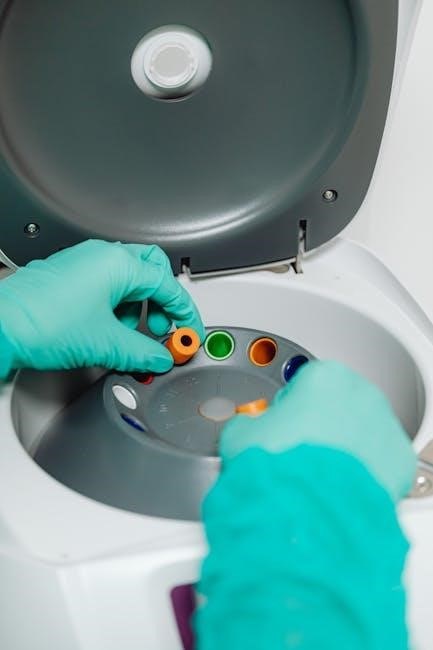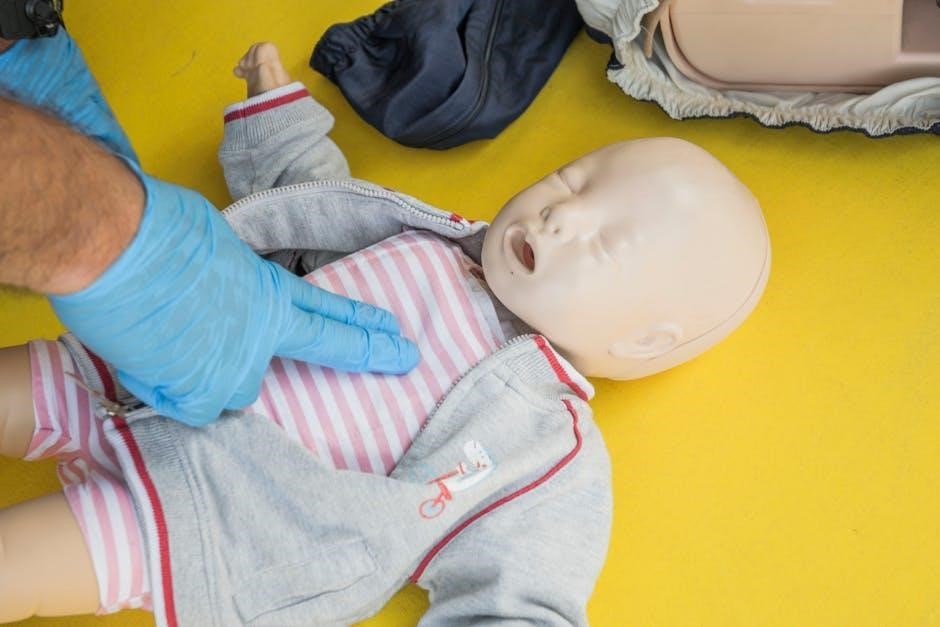A Safety Care Training Manual is a comprehensive guide designed to equip healthcare professionals with essential skills for preventing and managing challenging behaviors. It emphasizes practical strategies, legal compliance, and compassionate care approaches, ensuring a safe environment for both caregivers and individuals in their care. This manual serves as a foundational resource for training programs, promoting a culture of safety and well-being.
1.1 What is a Safety Care Training Manual?
A Safety Care Training Manual is a detailed guide outlining best practices, strategies, and protocols for preventing and managing challenging behaviors in care settings. It is specifically designed for caregivers, healthcare professionals, and support staff working with individuals who may exhibit dangerous or disruptive behaviors. The manual provides a structured framework for assessing risks, implementing safety measures, and responding to emergencies. It also covers legal and ethical considerations to ensure compliance with workplace safety standards. Available as a downloadable PDF, the manual serves as a practical resource for training programs, offering actionable insights and real-life scenarios to enhance caregiver competence and confidence. Its primary goal is to foster a safe and supportive environment for both care providers and the individuals they serve.
1.2 Purpose of the Safety Care Training Manual
The primary purpose of a Safety Care Training Manual is to provide caregivers and healthcare professionals with the knowledge, skills, and strategies needed to safely manage challenging behaviors and prevent crises. It aims to reduce incidents by promoting proactive approaches to risk assessment and de-escalation techniques; The manual also ensures compliance with legal and ethical standards, offering practical tools for documenting incidents and maintaining a safe environment. By focusing on both prevention and intervention, the manual empowers caregivers to create a supportive and respectful setting for individuals in their care. Ultimately, its goal is to enhance workplace safety while fostering a culture of compassion and understanding.
1.3 Importance of Safety Training in Care Settings
Safety training is crucial in care settings as it equips caregivers with the skills to prevent injuries, reduce workplace hazards, and manage challenging behaviors effectively. Proper training ensures compliance with legal standards and fosters a culture of safety, protecting both staff and patients. It also enhances the quality of care by promoting de-escalation techniques and empathy, leading to better outcomes for individuals in care. Additionally, safety training reduces incident rates, lowers costs associated with workplace injuries, and boosts employee confidence and morale. Regular updates to safety protocols ensure that caregivers remain prepared for emerging challenges, making safety training an essential component of any care setting.

Key Concepts in Safety Care Training
Safety Care Training focuses on risk assessment, emergency protocols, and legal standards to ensure safe, ethical, and effective care practices. It emphasizes proactive strategies to prevent crises and promote well-being in care settings.

2.1 Understanding Risk Assessment
Risk assessment is a critical component of safety care training, involving the identification, evaluation, and mitigation of potential hazards in care settings. It ensures that caregivers can anticipate and manage risks effectively, safeguarding both themselves and the individuals under their care. A thorough risk assessment considers environmental factors, individual behaviors, and systemic vulnerabilities. By implementing control measures such as personal protective equipment (PPE) and safety protocols, caregivers can reduce the likelihood of incidents. Regular workplace inspections and adherence to OSHA standards further enhance risk management. This process is cyclical, requiring continuous monitoring and adaptation to changing conditions. Proper risk assessment not only prevents harm but also fosters a culture of safety and accountability.
2.2 Emergency Procedures and Protocols
Emergency procedures and protocols are essential for ensuring prompt and effective responses to critical incidents in care settings. These procedures outline clear steps for managing crises, such as medical emergencies, violent behaviors, or natural disasters. Proper training in these protocols enables caregivers to act decisively, minimizing harm and ensuring safety for all involved. Key components include evacuation plans, first aid, and communication strategies. Regular drills and training sessions help caregivers maintain readiness and confidence. Adherence to these protocols not only protects individuals but also aligns with legal and ethical standards, promoting a culture of preparedness and accountability. Effective emergency responses rely on clear communication, teamwork, and documentation to ensure incidents are handled appropriately and lessons are learned for future improvements.
2.3 Legal and Ethical Standards in Safety Care
Legal and ethical standards form the backbone of safety care practices, ensuring that all interventions are conducted with respect, dignity, and accountability. These standards are designed to protect both caregivers and individuals in care, preventing abuse and neglect while promoting a safe environment. Key legal frameworks include OSHA regulations and workplace safety laws, which mandate specific protocols for hazard control and incident reporting. Ethical considerations emphasize the importance of informed consent, confidentiality, and the least restrictive intervention. Training programs must integrate these principles to ensure compliance and foster a culture of ethical decision-making. By adhering to these standards, caregivers uphold professional integrity and contribute to the well-being of those they support.

Components of a Comprehensive Safety Care Manual
A comprehensive safety care manual includes risk assessment, PPE guidelines, incident reporting, and emergency procedures, ensuring a structured approach to maintaining safety in care environments.
The introduction and overview section of a Safety Care Training Manual provides a foundational understanding of the manual’s purpose, scope, and key concepts. It outlines the importance of safety in care settings, emphasizing the need for proactive strategies to prevent incidents. This section also highlights the structure of the manual, guiding users through its components, from risk assessment to incident reporting. By establishing clear objectives, it ensures that all stakeholders understand their roles in maintaining a safe environment. The overview serves as a roadmap, helping users navigate the manual effectively and apply its principles in real-world scenarios to enhance safety and care standards.
3.2 Risk Assessment and Control Measures
Risk assessment is a critical component of the Safety Care Training Manual, focusing on identifying potential hazards and evaluating their likelihood and impact. This section provides a structured framework for conducting thorough risk assessments, enabling caregivers to anticipate and mitigate risks effectively. Control measures are outlined to address identified hazards, including procedural controls like safety protocols and physical controls such as personal protective equipment (PPE). The manual emphasizes the importance of documenting risk assessments and implementing preventive strategies to minimize incidents. Regular reviews and updates to these measures ensure adaptability to changing environments and emerging risks, fostering a proactive approach to safety in care settings.
3.3 Personal Protective Equipment (PPE)
Personal Protective Equipment (PPE) plays a vital role in safeguarding caregivers and individuals in their care from potential hazards. The Safety Care Training Manual emphasizes the proper selection, use, and maintenance of PPE to ensure maximum protection. This includes gloves, masks, eye protection, and other gear tailored to specific risks. Proper training on when and how to use PPE is essential to prevent exposure to biological, chemical, or physical hazards. The manual also highlights the importance of regularly inspecting and replacing PPE to maintain its effectiveness. By prioritizing PPE, caregivers can create a safer environment for both themselves and those they support, aligning with infection control and safety best practices.
3.4 Incident Reporting and Documentation
Incident reporting and documentation are critical components of a Safety Care Training Manual, ensuring transparency and accountability in care settings. All incidents, including injuries, near-misses, or behavioral challenges, must be documented accurately and promptly. The manual outlines the procedures for reporting incidents, emphasizing the importance of detailed records, including dates, times, and witness statements. Proper documentation helps identify patterns, prevent future incidents, and comply with legal and regulatory requirements. Caregivers are trained to maintain confidentiality while ensuring thorough reporting. This process not only supports continuous improvement in safety practices but also provides a clear audit trail for review and analysis. Effective documentation is essential for learning from incidents and enhancing overall care quality.

Implementing Safety Care Training
Effective implementation involves trained instructors, interactive sessions, and addressing trainee needs to ensure comprehensive understanding and practical application of safety care principles in real-world scenarios.
4.1 Training Objectives and Expectations
The primary objective of Safety Care Training is to equip participants with the knowledge and skills to safely manage challenging behaviors while ensuring the well-being of all individuals involved. Trainees are expected to actively engage in discussions, role-playing, and case studies to enhance their understanding of crisis prevention and intervention techniques. Respectful communication, punctuality, and full participation are essential expectations to foster a collaborative learning environment. Trainees should also communicate any personal limitations or concerns to the instructor to ensure a safe and inclusive training experience. By meeting these expectations, participants will gain the confidence and competence to apply Safety Care strategies effectively in real-world scenarios, aligning with the broader mission of promoting safety and compassion in care settings.
4.2 Trainer Qualifications and Responsibilities
Trainers delivering Safety Care Training must meet specific qualifications to ensure program effectiveness. They should hold certification as QBS Master Trainers, with extensive experience in clinical, educational, and management roles. Many trainers are Board-Certified Behavior Analysts (BCBAs), bringing expertise in behavioral interventions. Their primary responsibility is to deliver training that aligns with the Safety Care framework, using evidence-based methods like errorless teaching and prompting. Trainers must also ensure active trainee participation and understanding, addressing questions and concerns promptly. Additionally, they are responsible for maintaining updated knowledge of best practices and legal standards, fostering a safe and inclusive learning environment. Their role is crucial in equipping trainees with the skills needed to manage challenging behaviors effectively and compassionately.
4.3 Engaging Trainees in Interactive Sessions
Engaging trainees in interactive sessions is crucial for effective learning in Safety Care Training. Trainers should incorporate role-playing, group discussions, and hands-on activities to foster active participation. Encouraging trainees to share experiences and ask questions creates a collaborative environment. Interactive tools, such as scenario-based exercises, help trainees apply theoretical knowledge to real-life situations. Trainers should also use feedback mechanisms to ensure understanding and address any misconceptions. By making sessions dynamic and relevant, trainers can enhance retention and practical application of safety care skills. This approach ensures trainees are well-prepared to handle challenging behaviors confidently and compassionately in their work settings.
4.4 Addressing Trainee Needs and Concerns
Addressing trainee needs and concerns is essential for ensuring a successful Safety Care Training program. Trainers should actively listen to trainees, providing individualized support to address their questions and worries. Recognizing diverse learning styles, trainers can adapt their methods to accommodate visual, auditory, and kinesthetic learners. Trainees with physical limitations or prior injuries should be accommodated to ensure safe participation. Encouraging open communication fosters a supportive learning environment, allowing trainees to feel comfortable seeking clarification. By addressing concerns promptly, trainers can ensure trainees fully understand and feel confident in applying the skills learned. This tailored approach enhances overall training effectiveness and ensures a positive experience for all participants.

Effectiveness of Safety Care Training
The Safety Care Training Manual has demonstrated significant reductions in workplace incidents through structured, competency-based approaches. Data visualizations, such as bar charts, illustrate these measurable outcomes effectively, ensuring continuous improvement.
5.1 Measuring Training Outcomes
Measuring the effectiveness of Safety Care Training involves assessing trainee knowledge retention, skill application, and behavioral changes. Surveys, quizzes, and practical assessments are commonly used tools to evaluate understanding and competence. Incident reports and injury logs provide quantitative data to track improvements in workplace safety. Observing trainees in real-world scenarios helps verify their ability to apply learned strategies. Regular follow-ups ensure sustained compliance with safety protocols. Data visualization, such as bar charts, highlights trends in incident reduction, offering clear evidence of training impact. Continuous feedback loops allow for program refinement, ensuring alignment with organizational goals and compliance standards.
5.2 Impact on Incident Reduction
Implementation of a Safety Care Training program significantly reduces workplace incidents by fostering a proactive safety culture. Data visualizations, such as bar charts, demonstrate a clear decline in incidents post-training, showing tangible benefits. Trainees equipped with practical strategies and protocols are better prepared to identify risks and prevent accidents. The emphasis on legal and ethical standards ensures compliance, further minimizing hazards. Reduced incidents lead to lower costs associated with injuries, enhanced employee morale, and improved operational efficiency. Regular updates to the training manual keep practices current, sustaining long-term safety improvements and reinforcing the program’s effectiveness in creating a safer work environment.
5.3 Continuous Improvement Strategies
Continuous improvement is crucial for maintaining the effectiveness of Safety Care Training. Regular updates to the manual ensure alignment with the latest safety trends, legal standards, and practical methodologies. Feedback from trainees and incidents provides valuable insights for refining training content. Organizations are encouraged to adopt adaptive learning techniques, incorporating real-life scenarios and interactive sessions. Periodic reassessment of training outcomes helps identify gaps and areas needing enhancement. By fostering a culture of ongoing learning and adaptation, Safety Care Training evolves to address emerging challenges, ensuring sustained reductions in incidents and improved workplace safety over time. This proactive approach guarantees the program remains relevant and impactful in various care settings.

Legal and Regulatory Considerations
Understanding legal and regulatory standards is vital for ensuring compliance in care settings, protecting both staff and individuals through proper documentation and adherence to effective safety protocols.
6.1 OSHA Standards and Compliance
OSHA (Occupational Safety and Health Administration) standards are critical for ensuring workplace safety and compliance in healthcare settings. Employers must adhere to OSHA regulations, such as hazard communication, bloodborne pathogens, and personal protective equipment (PPE) standards, to protect employees and patients. A written Injury and Illness Prevention Program (IIPP) is required, outlining procedures for identifying and controlling hazards. Regular workplace inspections and documentation of incidents are essential for maintaining compliance. Employers must also provide training on OSHA standards, such as toolbox talks, to educate employees on safety protocols. Compliance with OSHA standards not only prevents injuries but also reduces legal liabilities, fostering a safer care environment for all. Customized safety manuals and OSHA resources can help organizations meet these requirements effectively.

6.2 Workplace Safety Laws and Regulations
Beyond OSHA standards, workplace safety laws and regulations encompass a broader framework to ensure employee and patient well-being. These include state-specific mandates, such as California’s Injury and Illness Prevention Program (IIPP), requiring employers to maintain written safety plans. Additionally, laws like the Occupational Safety and Health Act obligate employers to provide a hazard-free environment, even without specific standards for every scenario. Regular updates to these regulations mean employers must stay informed to adapt policies. Non-compliance can lead to penalties, emphasizing the need for thorough training and documentation. By integrating these laws into safety care training manuals, organizations ensure legal adherence and foster a culture of proactive safety management, ultimately protecting both staff and those under their care.
6.4 Maintaining Compliance Through Training
Maintaining compliance with safety laws requires consistent and high-quality training programs. Employers must ensure that all staff are well-versed in current regulations and workplace safety standards. Regular training sessions, including updates on new laws and industry best practices, are essential. Documenting these sessions ensures accountability and demonstrates a commitment to compliance. Interactive and engaging training methods, such as workshops and simulations, enhance employee retention of critical safety information. By integrating legal requirements into the Safety Care Training Manual, organizations can systematically address compliance needs while fostering a culture of safety and continuous improvement. This proactive approach not only meets regulatory obligations but also reduces workplace incidents and enhances overall safety standards. Regular audits and feedback mechanisms further reinforce compliance efforts, ensuring sustained adherence to safety protocols.

Customizing the Safety Care Manual
Customizing the Safety Care Manual involves tailoring content to specific workplace needs, incorporating company policies, and updating materials regularly to reflect industry changes and best practices.
7.1 Tailoring to Specific Work Environments
Tailoring a Safety Care Training Manual to specific work environments ensures relevance and effectiveness. By adapting content to match workplace conditions, such as healthcare or construction settings, the manual becomes more practical for employees. Incorporating company-specific policies, procedures, and local regulations enhances compliance and applicability. Regular updates are essential to reflect changes in industry standards, new equipment, or emerging risks. Customization also allows for the inclusion of site-specific safety protocols and emergency response plans, ensuring that trainees are well-prepared for their unique work environment. This approach fosters a culture of safety tailored to the organization’s needs, making training more impactful and aligning with organizational goals. Regular reviews and updates are critical to maintaining its effectiveness and relevance over time.
7.2 Incorporating Company Policies
Incorporating company policies into a Safety Care Training Manual ensures alignment with organizational standards and legal requirements. This integration includes workplace safety protocols, emergency procedures, and employee conduct guidelines. By embedding these policies, the manual reinforces the organization’s commitment to safety and compliance. Trainees gain clarity on expected behaviors and procedures, reducing confusion and enhancing adherence. Regular updates to the manual ensure that policy changes are reflected promptly. This customization also allows for the inclusion of company-specific forms, reporting mechanisms, and disciplinary actions related to safety violations. Such integration not only streamlines training but also fosters a unified approach to safety across all departments, ensuring consistency and accountability. This tailored approach strengthens the overall safety culture within the organization.
7.3 Updating Manual Content Regularly
Regular updates to the Safety Care Training Manual are crucial to ensure it remains relevant and effective. Changes in laws, advancements in safety practices, and new organizational policies necessitate frequent revisions. A systematic review process helps identify outdated content and incorporates fresh guidelines. Updates may include new safety protocols, revised emergency procedures, or updated legal standards. By maintaining current information, the manual continues to provide accurate guidance, reducing liability risks and enhancing compliance. Regular updates also reflect evolving workplace conditions, ensuring trainees are prepared for emerging challenges. This proactive approach fosters a culture of continuous improvement, safeguarding both employees and the individuals under their care. Regular updates are essential for sustaining a robust safety training program.
The Safety Care Training Manual empowers caregivers with essential skills, fostering a safe and supportive environment. By reducing incidents and ensuring legal compliance, it promotes compassionate, effective care.
8.1 Summary of Key Takeaways
The Safety Care Training Manual serves as a vital resource for caregivers, emphasizing the importance of risk assessment, emergency protocols, and legal compliance. It highlights strategies to reduce incidents and improve care outcomes. By fostering a proactive approach, the manual ensures a safe environment for both caregivers and individuals in their care. Continuous improvement through updated practices and ongoing training is encouraged to maintain high standards of safety and compassion. This guide is essential for promoting a culture of well-being and resilience in care settings.
8.2 Encouraging Ongoing Safety Practices
Encouraging ongoing safety practices is crucial for maintaining a safe and supportive care environment. Regular training updates and continuous learning opportunities help caregivers stay informed about the latest safety protocols. By fostering a culture of proactive safety, individuals can identify and mitigate risks effectively. Engaging trainees through interactive sessions and addressing their concerns ensures sustained adherence to safety standards. Additionally, incorporating feedback mechanisms allows for the refinement of safety practices over time. This commitment to continuous improvement not only enhances safety but also strengthens the overall quality of care provided. Ongoing safety practices are essential for building resilience and ensuring the well-being of both caregivers and those they support.
8.3 Final Remarks on Safety Care Training

Additional Resources
Explore recommended reading, access further training materials, and stay updated with the latest safety care trends. Visit www.safetymanualosha.com for comprehensive resources, including free safety manuals and OSHA guidelines.
9.1 Recommended Reading and References
For further learning, explore OSHA’s Small Business Handbook and Safety-Care training manuals. These resources provide practical strategies for workplace safety, legal compliance, and compassionate care. Refer to the NIOSH Hazard Review for insights into occupational hazards in healthcare settings. Additionally, the Mental Health Commission’s guidelines on individualized care planning offer valuable frameworks for holistic service delivery. Visit www.safetymanualosha.com for downloadable safety manuals and OSHA-related materials. These references ensure a well-rounded understanding of safety care principles and practices.
9.2 Accessing Further Training Materials
For additional resources, visit www.safetymanualosha;com to download free safety manuals and training materials. Platforms like SafetyHub and QBS also offer comprehensive toolkits and guides. Many websites provide customizable templates and interactive tools tailored to specific industries. Some materials may require registration or purchase, but they often include detailed frameworks for developing safety programs. Additionally, organizations like NIOSH and OSHA offer downloadable guides and training plans. These resources are designed to help employers and trainers create effective safety programs, ensuring compliance and fostering a culture of safety in the workplace. Explore these platforms to access a wide range of materials and stay informed about the latest safety care practices.
9.3 Staying Updated with Safety Care Trends
Staying informed about the latest trends in safety care is crucial for maintaining effective practices. Subscribe to newsletters and updates from reputable sources like OSHA and NIOSH to receive the newest guidelines and research. Attend industry webinars and workshops to learn about emerging strategies and tools. Follow safety care experts and organizations on professional platforms for real-time insights. Utilize online forums and communities dedicated to safety care to share knowledge and stay updated. Regularly review updated safety care training manuals and materials from trusted providers like SafetyHub and QBS. By staying connected to these resources, you can ensure your safety care practices remain current, effective, and aligned with industry standards.

